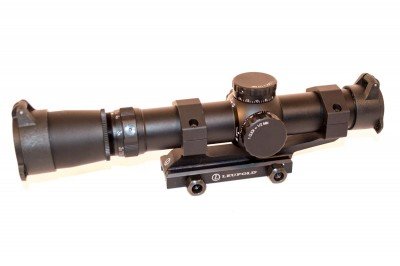night·mare [nahyt-mair]
The Trijicon 3×30 ACOG for 300 AAC Blackout.
noun
- a terrifying dream in which the dreamer experiences feelings of helplessness, extreme anxiety, sorrow, etc.
- a condition, thought, or experience suggestive of a nightmare: the nightmare of his years in prison.
- reflective of the process of trying to design an optic for the 300 AAC Blackout.
I got this from Websters, really. OK, maybe not all of it, but you have to admit that the definitions of “extreme anxiety” and “helplessness” fit pretty well, right?
There aren’t many 300 AAC Blackout specific optics on the market and I can guess why. Imagine trying to design a reticle that can accommodate the incredible variety of ballistic performance of that round. As we talked about a few weeks ago in the article about 300 Blackout Ammunition and Reloading, there is no “standard” ballistic performance profile. You can do pretty much whatever you want in a broad range of subsonic to supersonic performance. And therein lies the challenge for the optics gurus. How do you design a ballistic drop compensation reticle to account for… infinity plus one?
Wonky ballistics
Before going into the specifics of these two optics, let’s take a look at the ballistic challenges they have to overcome – all in the same reticle. For purposes of the trajectories shown here, let’s assume a zero yard zero, and we’ll use two common and “representative” projectiles and “standard” velocities. For the supersonic load, we’ll show the flight path of a Barnes TAC-TX 110-grain bullet. As a side note, Barnes just released a 120-grain version of this bullet – I can’t wait to try it. I’ll assume a velocity of 2,500 feet per second. For the subsonic load, we’ll use the classic 220 grain Sierra Matchking and assume a traveling speed of 1,050 feet per second.
The purpose of the “zero yard zero” is to compare the absolute, unadjusted flight paths of the two rounds. Basically, we’re looking at shooting each round exactly parallel to the ground to see how it falls over distance.
| Yards | Barnes 110 grain TAC-TX, 2,500 fps |
Sierra MatchKing 220 grain, 1,050 fps |
| 0 | 0.00 | 0.00 |
| 50 | -0.72 | -3.98 |
| 100 | -3.00 | -16.14 |
| 150 | -7.05 | -36.78 |
| 200 | -13.13 | -66.20 |
| 250 | -21.52 | -104.71 |
| 300 | -32.57 | -152.59 |
| 350 | -46.68 | -210.13 |
| 400 | -64.31 | -277.63 |
| 450 | -86.02 | -355.36 |
| 500 | -112.41 | -443.63 |
As you can see, the brick, I mean subsonic round, falls at about four times the rate of the supersonic. That’s a lot to account for. The idea behind a common reticle is to design it for the supersonic round and figure out a couple of realistic hold points for a short range trajectories of the subsonic round.
As we’ll look at in more detail this week, two premium optics companies have done just that. Trijicon and Leupold have each developed outstanding 300 AAC Blackout solutions. In my words, not theirs, the two options are not really comparable. They’re more like apples and oranges. Do you want applesauce or orange juice? More specifically, do you want adjustable precision or simplicity and speed?
The Trijicon offering borrows from the company’s ACOG line. It’s a fixed power optic that you adjust once, then shoot. And shoot. And shoot.
The Leupold offering is more of a scope tinkerer’s dream. With variable magnification and lots of fine lines in the reticle, you can get it to do whatever you want, out to very long ranges.
Let’s take a closer look at what each has to offer. One thing that both have in common is that they have boiled the ballistic ocean to two options at the extreme ends of 300 Blackout performance. The idea behind both the Trijicon and Leupold optics is that they design a dual reticle, with one-half mapped to supersonic projectiles in the 110-grain vicinity and the other mapped to subsonics in the 220-grain vicinity. If you want to use stuff in the middle ranges, it’s up to you to do some trial and error to map the reticle marks to specific ranges. On the plus side, at shorter and more reasonable ranges, it won’t really matter if you’re shooting 110, 125 or even 135-grain projectiles. That will only become significant past a couple hundred yards or so, so don’t get too concerned.
Be sure to check out Tom’s latest books! They are ON SALE now for a limited time!











Got something to say?